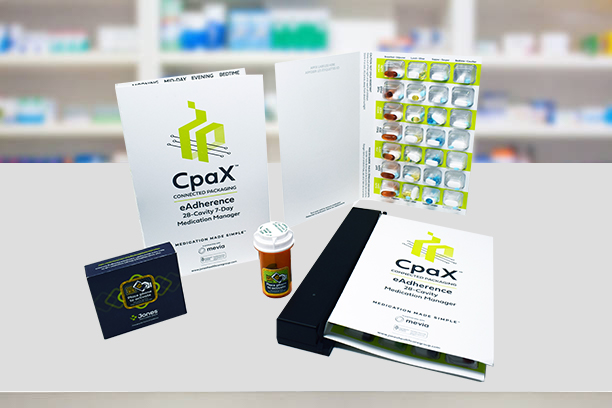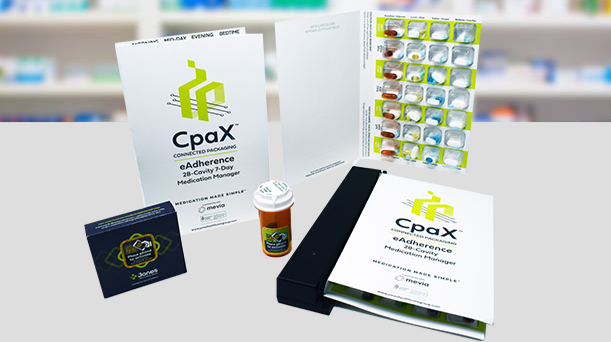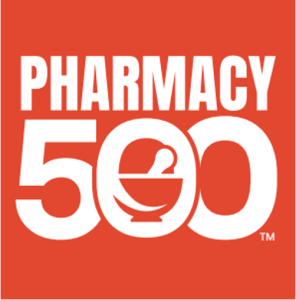Smart Packaging: Looks to Move Forward
Best opportunities are in healthcare, luxury items like liquor and cosmetics
By: David Savastano, Editor; Source: Printed Electronics Now

There has been a lot of interest in creating smart packaging, allowing companies to connect with consumers. RFID has been one success story; there have also been some interesting niche applications for printed and flexible electronics.
IDTechEx projects the market for electronic smart packaging to grow to $206 million in 2025. IDTech CEO Raghu Das noted that interest continues to grow.
“We’re certainly seeing more interest from brands, but not necessarily yet a greater presence of the technology in products,” Das said. “There have been many uses over the years, but not used for usually more than a fairly brief promotional period. Probably the longest-running example is the Duracell battery tester, still sold in some markets such as Europe.
“In healthcare, about two million smart blister packs have been used,” said Das. “RFID is also widely used. In liquor, we’ve seen small implementations, usually for a special feature or one-off promotion.”
Wolfgang Mildner, president of MSWtech, said he sees some demo projects, such as the OLED Coca-Cola bottle, as well as promising research projects.
“NFC integration in packaging is picking up and antenna and sensor integration will be future important areas, but it is still slow as far as I see now,” Mildner observed. “The biggest hurdle is cost because it’s mostly focused on marketing effects. My recommendation for a lasting market entry would be to focus on high-level packaging with value add on, like sensing and showing the filling level or temperature of high-value goods.”
Andrew Wong, manager, market development for Jones Healthcare Group, a leader in smart packaging converting for healthcare and other fields, reported that there is certainly a greater presence for flexible and printed electronics in smart packaging applications.
“Some attribute the recent surge in interest to the impact of COVID-19 on business and consumer behaviour, given consumers are spending more time interacting with digital content and seek contactless ways to interact with products,” Wong said. “That said, the benefits of electronic connected packaging – such as recurring remote engagement and real-time item-level data – have been aligned with corporate strategic roadmaps for the past decade.
“I believe the difference between today and 10 years ago is that ecosystems for these technologies have evolved significantly as demand has grown, which means connected packaging solutions are now feasible and more importantly, usable,” Wong noted.
Wong observed that the growth of these emerging technologies aligns very closely with the Gartner “Hype Cycle,” which is often cited, but many times overlooked.
“Even when a new technology is proven from a production standpoint, it takes time for scale to drive down costs, for supporting vendors to emerge and for stakeholders like businesses and consumers to gain familiarity with the technology before it really starts to take off,” he pointed out. “Today, we believe the stage is set for connected packaging technologies like NFC or printed sensors to make a commercial impact in the packaging market.”
Wong said that the apparel industry was one of the first to widely adopt UHF RFID on an item level for inventory control.
“Major retailers like Zara or Uniqlo have an RFID tag embedded into clothing tags, so they can gain real-time visibility into stock levels. For the apparel industry, this was crucial to address inventory demands arising from omnichannel distribution in their market,” Wong noted.
“The apparel industry is now taking this expertise in UHF RFID and expanding to include NFC for consumer engagement,” he added. “For example, we’ve seen executions where a retailer used an NFC clothing tag to enable retail associates to access support information during their in-store sales process, while also enabling consumer engagement at home after the sale. All the while, the retailer’s true goal was to improve channel security through this technology. This retailer suspected grey market diversion of their products was a growing issue – however, this was nearly impossible to track. So, they utilized NFC engagement as a trojan horse to uncover diversion in their supply chain.”
Wong noted that the liquor, wine and spirits industry has also seen several consumer-facing NFC executions, largely for consumer-facing brand security.
“You’ll see many executions where high-end brands use NFC’s security features to communicate the authenticity of a product to a consumer,” Wong said. “For example, a consumer could tap their phone onto an expensive bottle of wine to verify it is indeed authentic and also gain visibility into where the ingredients for this wine was sourced. Providing a consumer the peace of mind they are purchasing an authentic product is one of the many benefits that electronic connected packaging provides.
“Beyond NFC, we are seeing a sharp rise in interest from the pharmaceutical industry, particularly for solutions that can address medication adherence,” Wong added. “There is also heightened interest in connected consumer medical device test kits that can not only track test kit locations, authenticity and facilitate recalls, but also provide the consumer with enhanced rich media instructions to use kits properly and access test results.”
However, widespread usage of printed and flexible electronics has yet to become mainstream. Still, opportunities are developing, and industry leaders see new applications coming online. PragmatIC CEO Scott White said he is seeing increasing applications for the company’s flexible integrated circuits (FlexICs) in a range of smart packaging use cases.
“Many are focused on RFID or NFC functionality as a means of identifying, tracking and interacting with packaging,” White added. “But since the launch of our FlexIC Foundry, we have also seen a growing number of projects using our technology to develop interesting bespoke functionality such as sensors and processing (e.g. electronic nose).”
John Hannafin, global product manager, Sun Chemical Advanced Materials, said that Sun Chemical is seeing an increase in the presence of flexible and/or printed electronics in smart packaging.
“There continues to be a lot of smart packaging innovation being driven by the pharma industry,” Hannafin noted. “For example, new products are being introduced online which detect when and whether a medicine has been taken. These products drive compliance and improve patient outcomes. “There is hope that newer innovations, including smart sur-faces, will create the intimacy and engagement at the consumer level to improve the buying experience,” added Hannafin. “Other innovations are on the drawing board. It is clear that this space will drive more and more personal connections. We are seeing more inquiries for smart packaging, especially with regard to certain innovations, including a variety of sensors and printed batteries.”
“The potential applications for OPE in the printing and packaging sector are tremendous and broad, though cost remains a severe restriction,” said Klaus Hecker, managing director of the OE-A. “Nonetheless, the industry is being transformed as packaging becomes more than just an object to hold a product and printing becomes more and more functional.”
Key Opportunities for Smart Packaging
While some markets – healthcare and liquor come to mind – have seen the most use of smart packaging, there are other opportunities ahead.
Wong noted that the unique market demands as a result of the pandemic and the “new normal” that analysts are predict-ing post-pandemic have both contributed greatly to the growing interest in electronic connected packaging. He observed that adding electronics to packaging enables each connected package or product to become an IoT touchpoint.
“The ubiquity of smartphones that can read NFC – including more than 90% of smartphones manufactured with NFC reading capabilities, and the rise of consumer applications utilizing NFC such as Apple Pay, Google Pay, transit ticketing and government IDs, have created an environment where connected packaging is not just feasible from a technology and cost standpoint, but also has the critical mass required for large-scale consumer deployment,” he said.
Wong noted that Jones Healthcare is also seeing major brands and industry associations take a keen interest in connected packaging and how it could benefit their company and/or the industry. “For example, the Active & Intelligent Packaging Association recently hosted a brand challenge with Kraft Heinz at its international Virtual Congress, where companies were invited to share innovations in digital smart packaging for Kraft Heinz’s consideration. Jones Healthcare Group’s CpaX NFC Connected Packaging platform was selected as a winner of this challenge with an opportunity to discuss further with the global organization potential projects,” Wong reported.
Wong noted that Jones Healthcare is also seeing major brands and industry associations take a keen interest in connected packaging and how it could benefit their company and/or the industry. “For example, the Active & Intelligent Packaging Association recently hosted a brand challenge with Kraft Heinz at its international Virtual Congress, where companies were invited to share innovations in digital smart packaging for Kraft Heinz’s consideration. Jones Healthcare Group’s CpaX NFC Connected Packaging platform was selected as a winner of this challenge with an opportunity to discuss further with the global organization potential projects,” Wong reported.
“We see interest in very different areas. Brand owners might want to raise awareness at the point of sale by integrating lighting in the package or use NFC to set up interaction with the end customer and provide additional information on the product,” Hecker pointed out. “Anti-tamper and anti-counterfeiting protection protect customers and suppliers from manipulation during the entire logistic chain. We also see a growing interest in smart blister packs for pharmaceutical applications, supporting the patient in compliance. Cool-chain monitoring is expected to become more widespread.
“In particular healthcare/pharmaceutical and brand owners (from liquor, olive oil, ticketing, other consumer brands) make use of printed electronics in smart packaging,” said Hecker. “Smart packaging applications by Karl Knauer, Ynvisible, Schreiner, PragmatIC are prominent examples. Also, RFID/NFC for logistics is more and more used – starting from the pallet level, via box level down to single item-level tagging in the future.”
Hannafin said that the pre-packaged meal industry is driving a lot of sensor development to assure the meals arrive fresh. “Tracking temperature, looking for spoilage and enhancing the consumer experience are all driving the incorporation of printed electronics in the smart packaging arena,” he noted. Wong said he is currently most excited about Jones Healthcare’s work surrounding printed electronics in packaging to track medication adherence.
“At Jones Healthcare Group, we have been able to use a proprietary process to print conductive traces of ink onto paperboard. When we print these conductive patterns over blister packaging for medication, they serve as break sensors that can detect when a blister cavity is opened or closed,” said Wong. “By connecting this disposable blister pack to a reusable transmitting device (basically a cell phone without a screen), we can monitor and transmit in real-time whether a patient has removed medication from the package,” Wong added. “We have pilot tested this solution in Europe, and are currently running live patient trials with pharmacy chains in the United States. “Essentially, by including printed electronics in packaging, we can provide a new level of visibility into medication adherence,” he concluded. “And, importantly, the direct impact medication adherence has on patient well-being is what makes projects like this so exciting on a personal and professional level.”
Challenges Ahead
There are a number of technical hurdles that have had to be overcome, with more to do to further the growth of smart packaging. Wong said that Jones Healthcare has largely overcome any technical hurdles. “The last for us at Jones was integrating electronics into packaging at high speed and scale,” Wong added.
Das said that there can be many benefits depending on the product, including reduced theft and losses, improved safety, recalls, tamper and counterfeiting, enhancing the brand and regulatory adherence.
“Smart packaging enables customer interaction, including providing additional product information, brand awareness, authentication, anti-tamper, tracking and tracing, freshness monitoring, and patient support in medication intake/compliance,” Hecker said.
White said that for PragmatIC, the biggest hurdles the company has had to overcome to date are the development of the technology platform for ultra-low-cost flexible ICs, and the FlexLogIC manufacturing model to deliver high-yield scalable production. “Further growth requires additional scaling of manufacturing (we are already planning our next line) as well as the continued development of the ecosystem for complete solutions, e.g. working with cloud software companies who translate item-level data into meaningful and actionable insights for brands and consumers,” added White.
“Offering solutions and innovations in printed electronics to an OEM has a well-established path and well-connected supply chain,” said Hannafin. “Offering these same solutions to consumer brand groups and their traditional manufacturing base offers special challenges. Each of these target markets have their own language. However, the language barrier is slowly being broken, in large part because the consumer is increas-ingly demanding innovations in smart packaging. The brand groups recognize that the in-store retail environment has to compete with the convenience, interactivity and connectivity of online shopping.”
Outlook for Smart Packaging
Smart packaging specialists see opportunities ahead for intel-ligent packaging. “We can see a path to our vision of a trillion smart items even just with RFID/NFC applications,” White said.
“We can see a path to our vision of a trillion smart items even just with RFID/NFC applications,” White said. “The potential applications for organic and printed electronics (OPE) in the printing and packaging sector are tremendous and broad, though cost remains a severe restriction,” Hecker noted. “Nonetheless, the industry is being transformed as packaging becomes more than just an object to hold a product and printing becomes more and more functional.”
Hannafin observed that smart packaging is no longer desirable, it’s inevitable. “Data acquisition of buying habits is a necessity at the store level to compete with the digital shopper,” added Hannafin. “Innovative ways to attract and enhance the consumer buying experience within the retail store environment is increasingly essential. Consumer interest in wearables, smart packaging, and new cost-effective displays will create a more interactive environment in the retail store.”
“I believe the best electronic packaging executions have yet to be created,” Wong concluded. “For those reading this, I invite you to remember the early days of digital publications. The quality of user interfaces for online publications pale in comparison to today. Think about how quickly web design evolved to create the incredible web experiences we see today. Think about how many people could have predicted the way the ‘web’ looks today. My outlook is that electronic connected packaging will not only continue to grow, but we will also see more and more wonderfully unpredictable implementations emerge, as more creative minds enter the fray.”








